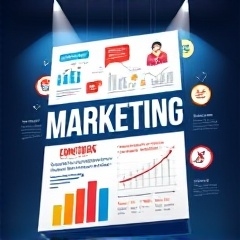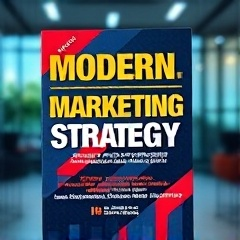Review of the book "Neuromarketing: Visualization of Emotions" by Traindl Arndt. On the impact on consumer emotions
He emphasizes how, for example, the correct combination of color and shape of products increases advertising conversion - and these are not abstract facts, but the result of real-life cases.
- His recommendations don't go into empty talk.
- Whether it's launching a new line of shampoo or designing a banner for an online store, each of the author's suggestions is, in essence, an action guide.
- Reading it, you experience a mix of admiration and professional envy.
- Why are such simple tools like visualization of emotions still perceived as know-how?
- Arndt skillfully balances between theory and practice.
You get the feeling that marketing is not just about numbers, but also about being able to hear the heartbeat of your audience.
Key Concepts and Their Analysis

Arndt skillfully reveals the essence: not a dry theory, but a concrete analysis of the mechanisms that make wallets open faster than eyes at a morning meeting.
On the pages of the book, you won't find reasoning like "maybe it affects", but clear calculations:
- Visual triggers can increase interest in a product by almost one and a half times.
- Each concept is illustrated in such a way that you start mentally rearranging buttons and banners on your own website.
- Where a shade plays on trust, and where a font knocks off the desire to click.
Arndt not only shows how emotions become fuel for the marketing machine, but also breaks down how visual signals penetrate the depths of consumer choice.
At the same time, he is generous with details, providing crystal-clear examples from the world of big brands:
- Moving the logo a couple of centimeters results in million-dollar changes in conversion.
As a result, it feels like the book is not just a collection of trendy ideas, but a textbook for those who want not to drift with the current, but to manage the emotions of the buyer with surgical precision.
Who is the book for
Diving into the chapters, you catch yourself thinking: this book is not for idle curiosity or theoretical excursions in the spirit of "what are the trends there". It is tailored for those who are torn between analytics and creativity on a daily basis — marketers, business owners, digital strategists, creative directors. It's for them that there are not mythical discussions about the nature of desire, but tools that can be implemented tomorrow, without waiting for the next sales report.
The author doesn't flatter the reader, doesn't coddle beginners:
- if you work at the intersection of psychology and sales,
- if you're tired of guessing why one button gives a conversion rate of 14%, and another — a meager 5% — this is your go-to guide.
Even psychologists will find some tasty morsels here: instead of endless theories — illustrative cases from real business, where fine-tuning visual elements suddenly becomes the key to customer loyalty.
The book doesn't seek a wide audience — it filters readers, leaving only those who are ready to apply the knowledge gained at the forefront of modern trends and achieve tangible results, rather than simply adding to their collection of trendy terms.
About the author and his significance in marketing

If we put aside common clichés like “industry guru” for a minute, it becomes clearer that Arndt has long become someone whose opinion changes the direction of entire marketing teams. He is not interested in abstract conclusions just for the sake of a fancy phrase:
- Every statement is the result of dozens of experiments and meticulous analysis.
- Honest acknowledgment of mistakes on the path to discovering patterns between visual stimulation and audience reaction.
The author has not only published in industry journals, but also worked on specific projects with increased efficiency of advertising campaigns by tens of percent - without magic, just methodical work with perception and behavior.
In marketing circles, the surname Arndt does not evoke indifference: his research on emotional response to visual stimuli is cited in reports, and practical conclusions are discussed at industry conferences.
It is not surprising that it was his work that became a kind of bridge between dry brain theory and live customer reactions, and not just another fashionable compilation without empirical support.
The Place of the Book in Modern Marketing Literature
Against the backdrop of a dull series of bestsellers, where authors seem to be retelling the same truths to each other as if following a template, this work stands out from the general mass — here finally appears the fresh air that both top managers and beginner targetologists are hunting for.
Not just a set of beautiful infographics and adapted case studies, but a thoroughly developed system that has found a loophole between academism and reality. Arndt doesn't follow the beaten path of popular textbooks: his approach feels like surgical precision — he dissects the underlying processes that most colleagues either sidestep or shyly hide behind vague formulations.
That's why his book lives outside of temporary trends: it doesn't parasitize on the hype around "digital emotions," but offers tools that are already changing the landscape of the industry today. Such a thorough work literally displaces superficial brochures from the shelves of business literature, setting a new standard for everyone who is used to thinking not in slogans, but in specifics — and this is perhaps the best indicator of its place among modern specialized literature.
| Key Aspects | Description | Advantages |
|---|---|---|
| Fresh Air | Unique Content | |
| Thoroughly Developed System | Between Academism and Reality | |
| Surgical Precision | Analysis of Processes | |
| Tools for Change | Not Parasitizing on Hype | |
| New Standard | Thinking in Specifics |
Relevance of the publication at the current moment

It's hard to overestimate the timeliness of this book's release: when the market is overheated to the limit, and every second brand is desperately looking for ways to stand out, a detailed analysis of the mechanisms of influencing consumer feelings becomes not just useful - it's vital.
- In an era when competitors are closing in with clockwork precision.
- User loyalty is measured by the number of swipes.
- The author doesn't limit themselves to general reasoning, but arms the reader with tools.
- The author's personal experience inspires trust and leaves the impression that you're holding not just another theoretical contraption, but a real guide to action.
Against the backdrop of current realities: when emotions become currency in the fight for attention, the book not only meets the demands of the time - it anticipates them, offering solutions that will become mainstream tomorrow.
Fundamental Marketing Concepts

If you disregard the advertising fanfare and look deeper, it becomes clear: the author is not pulling the wool over your eyes, but confidently puts on the shelves the basic principles, without which any promotion is doomed to stall.
- Each term is not a dummy from marketing vocabulary, but a working tool tested by real cases.
- Proper use of the color palette increases the average interaction time on the site up to 43 seconds - a result that can be decisive in a competitive race.
- Reading explanations about attention triggers, you involuntarily catch yourself thinking: here it is, an explanation of that very "click" in the client's head, which turns an indifferent viewer into a loyal customer.
- The text does not slide into boredom, but catches with specifics and a fresh look at long familiar categories.
Making you reconsider even such truisms as “first impression” and “visual contact”.
Innovative ideas and modern trends
If in the introductory chapters the reader only warms up their mental muscles, then here begins a real intellectual heptathlon: the author without hesitation or unnecessary equivocation brings up for discussion ideas that just yesterday seemed to be the prerogative of laboratories and futuristic reports, and today are already being implemented in the digital departments of large FMCG companies.
Operating with fresh data — for example, the results of monitoring micromimicry when watching commercials, Arndt not only illustrates how consumer emotions are recorded and "translated" into the language of metrics, but also shows how this data is instantly transformed into strategic decisions:
- Adjusting the tone of communication
- Rebuilding the user route on the website
It feels like the author is armed not only with analytical tools, but also with a kind of moral compass that is highly sensitive to the excesses in the pursuit of clicks and "engagement" — not by chance among the trends he highlights:
- Ethics of data processing
- Transparency in communications
This becomes critically important in the era of total personalization. However, Arndt doesn't stop there: he skillfully fits into the overall context such innovations as the use of neuro-research to optimize offline retail spaces, supporting his theses with the results of A/B tests with sales growth.
Reading these chapters, you catch yourself thinking: what seemed like science fiction a year ago is now a part of the daily routine of a marketer, and, I confess, this causes not only professional excitement but also healthy wariness.
Applicability of Concepts in Modern Business
In reality, the methods described in the book are not gathering dust on a theoretical shelf: their actual implementation in corporate processes causes a slight tremor among pragmatic business analysts and a nod of approval from risk managers.
The author consistently examines how quantitative data on customer reactions to banal banner color changes or revisions to storefront layout instantly become fuel for increasing conversion rates.
As you read, you can't help but compare it to your own experience - there is no room for slogans like "trust your emotions" here; instead, there are clear algorithms where every step is backed by measurable results. To be honest, it's impressive and a little intimidating at the same time: you can't help but wonder where analytics end and manipulation begins.
The book teaches you not just to catch insights about audience behavior, but to handle them in a way that doesn't go overboard - and that's where the most valuable skill of a modern marketer lies, one who is confident that data is not an end in itself, but a tool for fine-tuning, almost surgically adjusting commercial processes.
| Methods | Effect | Icon |
|---|---|---|
| Color Change Analysis | Conversion Rate Increase | |
| Storefront Layout Change | Increased Time on Site | |
| Facial Expression and Gesture Analysis | Response Rate Growth |
Case studies and examples from real business
Unlike endless "in-vacuum" discussions, here we present concrete stories of companies for which:
- changing the color scheme on the website
- rearranging products on the display
resulted not just in a checkbox on a checklist, but in a double-digit increase in metrics. There's no need to guess how applicable this is in practice: the reader is presented with numbers and facts that make them rethink their own approaches to working with their audience.
When you see how грамотная корректировка визуальных стимулов ( competent adjustment of visual stimuli) leads to an increase in average interaction time or a sharp jump in response to automated messages, you can't help but wonder — what would happen if similar methods were implemented here?
There are no empty promises here: each case study comes with an analysis of mistakes and subtleties that those who rely on the "hit-or-miss" approach tend to miss. The reader, even if they're far from analytics, can sense that these examples are driven not just by a desire for experimentation, but also by respect for the subtle psychology of the consumer.
Translated to:Case studies and examples from real business
Unlike endless theoretical discussions, here we present concrete stories of companies for which:
- changing the color scheme on the website
- rearranging products on the display
resulted not just in a checkbox on a checklist, but in a double-digit increase in metrics. There's no need to guess how applicable this is in practice: the reader is presented with numbers and facts that make them rethink their own approaches to working with their audience.
When you see how effective adjustment of visual cues leads to an increase in average interaction time or a sharp jump in response to automated messages, you can't help but wonder — what would happen if similar methods were implemented here?
There are no empty promises here: each case study comes with an analysis of mistakes and subtleties that those who rely on the "hit-or-miss" approach tend to miss. The reader, even if they're far from analytics, can sense that these examples are driven not just by a desire for experimentation, but also by respect for the subtle psychology of the consumer.
Strengths of the publication
What really sets this publication apart from the monotony of textbooks and dull manuals is its ability to speak to the reader in the language of facts that don't gather dust in tables, but literally drive business forward.
- No hint of abstract reasoning just for the sake of a pretty phrase:
- Every statement is accompanied by data that cannot be ignored.
- Analysis of successful and unsuccessful moves dives into the details where the devil of marketing decisions hides.
- Scrupulous analysis of cause-and-effect relationships — won't stop at a banal "worked/didn't work".
- Methodically reveals why some techniques cause a wow-effect, while others fall flat.
- Reading it, you can't help but feel healthy professional irritation:
- Why do we still have everything done clumsily, when here's a step-by-step guide, written without academic dust and tedium.
This book is not just a theoretical foundation, but a full-fledged tool for those who want to see real returns on their efforts, not just make a show of bustling activity.
Critical Analysis
However, despite the scrupulousness and abundance of illustrative examples, one cannot ignore the author's excessive confidence in the universality of their approaches: many chapters convey the impression that buyers' emotions can be neatly lined up, forgetting about the differences in mentalities, industry nuances, and specifics of local markets.
While reading the case studies, I caught myself thinking that some examples are clearly tailored to Western realities, and attempting to extrapolate them to Russian or Asian markets evokes, if not skepticism, then at least caution: where the author's visual trigger works, we might experience utter bewilderment.
It is particularly striking that, despite the author's affinity for numbers, they sometimes idealize the consumer as a rational actor, although modern research increasingly suggests that choice is often irrational.
This one-sided view leads to the following conclusions:
- The book is rich in tools
- In the hands of an unprepared reader, these tools may be ineffective
- It is necessary to consider cultural and behavioral pitfalls
Tools and techniques for practical use
When it comes to a set of practical solutions, the book is literally filled with diagrams, checklists, and curious "cheat sheets" for daily work with consumer reactions:
- Basic facial expression tracking
- Advanced eye-tracking techniques
- Voice tone analysis
The author confidently lays out the tools on the table:
- Tables for calculating the emotional response index
- Step-by-step algorithms for evaluating the visual series of advertising
- Detailed protocols for conducting focus groups with measurements of physiological parameters
But what's disturbing is that behind the abundance of technical details, the danger of mechanical copying is looming large: if you follow the instructions thoughtlessly, it's easy to slide into formalism, and the work itself risks turning into a circus with devices, where instead of live contact, there are only graphs and sensors.
However, for those who are not afraid to dig into the data and are ready to compare their observations with the real behavior of the audience, these tools can be a serious help - but only on the condition that behind the numbers, a person with their unpredictable reactions and context, which the author, alas, does not always take into account, is not lost.
| Tool | Description | Advantages |
|---|---|---|
| 📊 Emotional response | Tables for calculating the index | Simplifies analysis |
| 👁️ Eye-tracking | Eye-tracking techniques | Deep understanding of visual perception |
| 💬 Tone analysis | Voice analysis methods | Helps in interpreting emotions |
Popularity of the real edition

One thing that can't be taken away is the hype surrounding this book — it's being discussed hotly on specialized forums, like the latest inflation data, and it appears in the lists of recommended literature for marketers with enviable regularity.
- Circulation: just last year, the reprint sold seven thousand copies.
- Ratings: on «LitRes» ratings consistently stay above four and a half stars with one and a half thousand reviews.
- Social media: young professionals post photos with bookmarks and underlines, as if demonstrating: I'm in the know, I'm armed.
However, there's a feeling that people often don't read it to the end, and then loudly quote a couple of paragraphs at an interview — because, despite the fashionable wrapping, the author demands thoughtfulness and patience, which those rushing for likes and KPI clearly lack.
The book has become a kind of admission ticket to the circle of "advanced" ones, but, as it often happens, the noise around it sometimes overshadows the real number of people who have actually implemented at least half of the proposed tools.
Other works by the author
As for Arndt's other works, the situation is no less intriguing: his previous publications - be it "The Mastery of Retail Branding" or laconic essays on the digital age - never garnered such a strong response, although they were always thematically on the cutting edge of the modern agenda.
In them, Arndt tackled the most complex questions:
- How brands penetrate the depths of motivation
- To what extent digital algorithms can influence decision-making
- Where is the fine line between manipulation and genuine empathy
However, contrary to expectations, these works did not receive a wide resonance: on specialized platforms, they were discussed much more modestly, and the circulation, compared to the current success, looked simply pale.
Perhaps the reason lies in the fact that the author's early works were guilty of excessive academicism and were designed for a narrow circle of initiates, while the current publication, although requiring serious perseverance, still better balances between the complexity of presentation and practical benefit.
Personal reading experience made it possible to catch this shift: if earlier it was necessary to fish out practical ideas among theoretical thickets with a magnifying glass, now methods and tools, although requiring effort, are presented much more transparently.
However, fans of the old Arndt may frown slightly - they say that the same signature analytical scope and depth have taken a backseat to a wide audience, but this is precisely what ensured the current book's status as almost a cult guide for marketers of the new wave.
Comparison with other works by the author
Looking back at Arndt's previous achievements, it's easy to notice that his current work is not just another brick in the wall of scientific research, but almost a major overhaul in his personal methodological apartment. Previously, the author seemed to deliberately keep the reader at an academic distance:
- instead of live case studies, there were cumbersome schemes,
- instead of tools, there were abstract calculations,
- and only occasionally did sparks of practical meaning emerge through the veil of theory.
Today, flipping through the fresh pages, you catch yourself thinking: I'm faced with a completely different Arndt, who is not afraid to unpack his toolkit and show how specific visual stimuli actually drive customer choices - not just in theory, but with first-hand examples.
This is where the main dividing line between the old and new stages of his work lies:
- if previously emotional triggers existed somewhere in the clouds of abstraction,
- now they are broken down into categories, with numbers and illustrations, like in a textbook for ambitious practitioners.
Personally, this turn came as a breath of fresh air: for the first time in a long time, the material is not just interesting, but also applicable, and the old heaviness has left only a faint shadow, reminding us of how much water has flowed since the author's first publications.
| Parameter | Old approach | New approach |
|---|---|---|
| Case studies | Cumbersome schemes | Live examples |
| Tools | Abstract calculations | Concrete tools |
| Emotional triggers | In the clouds of abstraction | Broken down into categories |
Similar literature by other authors
Gazing at the bookshelves where the works of Lindstrom, Damasio, and Pratkel sit alongside each other, you can't help but compare - who among them can truly pull the reader out of the depths of theory and give them a practical tool?
- Lindstrom traditionally wraps his conclusions in a glittering array of engaging stories, but often leaves the practicing marketer alone with the question: «What to do in practice?»
- Damasio, on the other hand, dives into the depths of neurophysiology, where emotion is viewed more as an abstract phenomenon than as a lever to influence the buyer.
- Arndt surprises with his "down-to-earth" grip: here you won't find elusive generalizations or endless references to laboratory experiments without a connection to real business.
Unlike his colleagues, he doesn't get lost in vague reasoning about «brand magic», but literally lays out step-by-step scenarios - take and implement.
To be honest, among modern literature where every other author promises to «hack» the consumer's brain, this approach seems like a breath of fresh air: no esotericism, just numbers, concrete examples, and ready-to-launch tools.
It's as if Arndt finally heard the practitioners' requests and decided not just to tell, but to teach - and in this, his book favorably stands out from the worn-out bestsellers by famous theorists.
